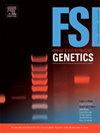全基因组DNA甲基组分析用于区分同卵双胞胎
IF 3.1
2区 医学
Q2 GENETICS & HEREDITY
引用次数: 0
摘要
在目前的法医环境中,源于基因组差异的短串联重复序列(STR)分析具有很高的准确性,被广泛用于个体识别。然而,如果当事人是同卵双胞胎(MZ),他或她的DNA图谱与他或她的双胞胎完全相同;因此,STR分析不能区分它们。因此,即使在MZ双胞胎中也有不同模式的DNA甲基化作为一种有希望区分MZ双胞胎的标记而受到关注。这些表观遗传模式受环境因素和年龄的影响,在双绒毛膜-双羊膜、单绒毛膜-双羊膜和单绒毛膜-单羊膜三种类型的MZ双胞胎中观察到不同的DNA甲基化模式。为了比较这三种类型的MZ双胞胎的DNA甲基化谱,并确定区分MZ双胞胎的共同标记,我们收集了54对MZ双胞胎的脐带血样本,并使用Human MethylationEPIC v2.0平台分析了他们的DNA甲基化谱。在三种类型的MZ双胞胎中观察到的DNA甲基化差异发生在免疫相关区域。在单绒毛膜-双羊膜双胞胎和单绒毛膜-单羊膜双胞胎中发现的差异甲基化基因在细胞因子信号和白细胞介素信号相关区域富集。然而,双绒毛膜-双羊膜双胞胎的差异甲基化基因在突触和神经元系统的PPI中富集。为了促进双胞胎的区分,我们选择了MZ双胞胎之间不同的CpG位点组合,并在两个独立的队列中验证了这种CpG组合,该队列包括118对英国MZ双胞胎和47对韩国MZ双胞胎。此外,这些选定的DNA甲基化标记在60个独立的MZ双胞胎样本中使用焦磷酸测序进行评估。我们的研究结果表明,MZ双胞胎在出生时观察到的甲基化差异会持续一生。因此,这些CpG位点组合可以作为有价值的甲基化标记,在法医案件中,嫌疑人是MZ双胞胎。本文章由计算机程序翻译,如有差异,请以英文原文为准。
Genome-wide DNA methylome profiling to differentiate monozygotic twins
In the current forensic environment, short tandem repeat (STR) profiling originating from genomic differences is highly accurate and widely used to identify individuals. However, if the person of interest is a monozygotic (MZ) twin, his or her DNA profile is identical to that of his or her twin; thus, STR profiling cannot discriminate between them. Therefore, DNA methylation, which is known to have different patterns even in MZ twins, has attracted attention as a promising marker to differentiate MZ twins. These epigenetic patterns are affected by environmental factors and age, and distinct DNA methylation patterns have been observed among the three types of MZ twins, i.e., dichorionic-diamniotic, monochorionic-diamniotic, and monochorionic-monoamniotic. To compare DNA methylation profiles among these three types of MZ twins and identify common markers to differentiate MZ twins, we collected cord blood samples from 54 pairs of MZ twins and analyzed their DNA methylation profiles using the Human MethylationEPIC v2.0 platform. The differences in DNA methylation observed among the three types of MZ twins occurred in immune-related regions. Differentially methylated genes identified in both monochorionic-diamniotic and monochorionic-monoamniotic twins were enriched in cytokine signaling and interleukin signaling-related regions. However, differentially methylated genes in dichorionic-diamniotic twins were enriched in PPI at synapse and the neuronal system. To facilitate twin differentiation, we selected a combination of CpG sites that differed between MZ twins and validated this CpG combination in two independent cohorts comprising 118 British MZ twin pairs and 47 Korean MZ twin pairs. Additionally, these selected DNA methylation markers were evaluated in 60 independent samples of MZ twins using pyrosequencing. Our results suggest that the methylation differences observed between MZ twins at birth persist throughout life. Consequently, these CpG site combinations could serve as valuable methylation markers in forensic cases where a suspect is a MZ twin.
求助全文
通过发布文献求助,成功后即可免费获取论文全文。
去求助
来源期刊
CiteScore
7.50
自引率
32.30%
发文量
132
审稿时长
11.3 weeks
期刊介绍:
Forensic Science International: Genetics is the premier journal in the field of Forensic Genetics. This branch of Forensic Science can be defined as the application of genetics to human and non-human material (in the sense of a science with the purpose of studying inherited characteristics for the analysis of inter- and intra-specific variations in populations) for the resolution of legal conflicts.
The scope of the journal includes:
Forensic applications of human polymorphism.
Testing of paternity and other family relationships, immigration cases, typing of biological stains and tissues from criminal casework, identification of human remains by DNA testing methodologies.
Description of human polymorphisms of forensic interest, with special interest in DNA polymorphisms.
Autosomal DNA polymorphisms, mini- and microsatellites (or short tandem repeats, STRs), single nucleotide polymorphisms (SNPs), X and Y chromosome polymorphisms, mtDNA polymorphisms, and any other type of DNA variation with potential forensic applications.
Non-human DNA polymorphisms for crime scene investigation.
Population genetics of human polymorphisms of forensic interest.
Population data, especially from DNA polymorphisms of interest for the solution of forensic problems.
DNA typing methodologies and strategies.
Biostatistical methods in forensic genetics.
Evaluation of DNA evidence in forensic problems (such as paternity or immigration cases, criminal casework, identification), classical and new statistical approaches.
Standards in forensic genetics.
Recommendations of regulatory bodies concerning methods, markers, interpretation or strategies or proposals for procedural or technical standards.
Quality control.
Quality control and quality assurance strategies, proficiency testing for DNA typing methodologies.
Criminal DNA databases.
Technical, legal and statistical issues.
General ethical and legal issues related to forensic genetics.

 求助内容:
求助内容: 应助结果提醒方式:
应助结果提醒方式:


